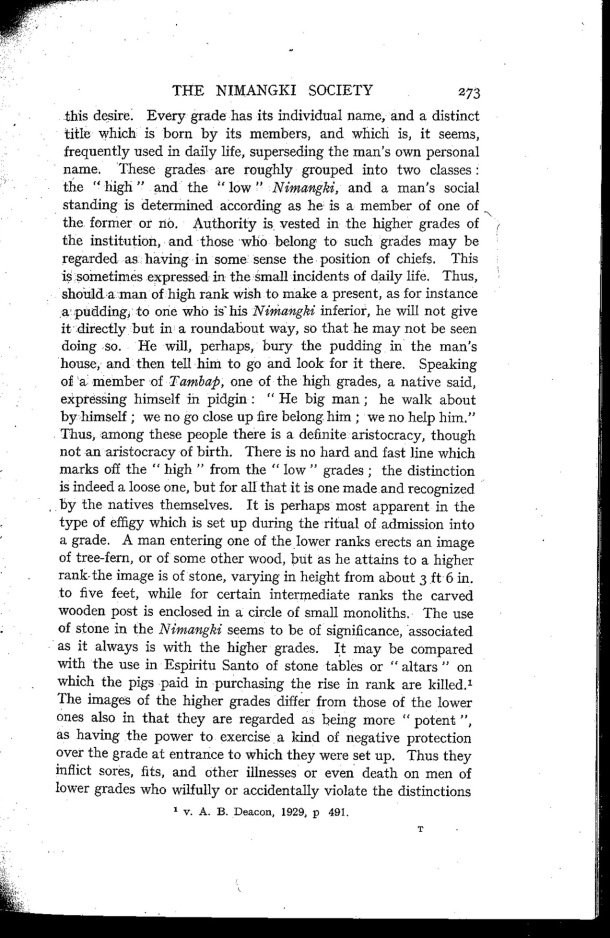|
|  [Note: this transcription was produced by an automatic OCR engine]
THE NIMANGKI SOCIETY 273
this desire. Every grade has its individual name, and a distinct
title which is born by its members, and which is, it seems,
frequently used in daily life, superseding the man’s own personal
name. These grades are roughly grouped into two classes :
the " high â€ù and the " low " Nimcmg/ei, and a man's social
standing is determined according as he is a member of one of
the former or no. Authority is vested in the higher grades of
the institution, and those ‘W110 belong to such grades may be
regarded as having-in some sense the position of chiefs. This
is sometimes expressed in the small incidents of daily life. Thus,
should -a man of high rank wish to make a present, as for instance
ahpudding,‘-to one who is" his Nimangki inferior, he will not give
itdirectly but in a roundabout way, so that he may not be seen
doing so. He will, perhaps, bury the pudding in the man's
house, and then tell him to go and look for it there. Speaking
of ’a' member of -Tambap, one of the high grades, a native Said,
expressing himself in pidgin: “He big man; he walk about
by himself ; we no go close up ï¬Åre belong him ; we no help him.â€ù
Thus, among these people there is a deï¬Ånite aristocracy, though
not an aristocracy of birth. There is no hard and fast line which
marks off the “ high " from the “ low " grades ; the distinction
is indeed a loose one, but for all that it is one made and recognized
by the natives themselves. It is perhaps most apparent in the
type of effigy which is set up during the ritual of admission into
a grade. A man entering one of the_lower ranks erects an image
of tree-fern, or of some other wood, but as he attains to a higher
rank»the image is of stone, varying in height from about 3 ft 6 in.
to ï¬Åve feet, While for certain intermediate ranks the carved
wooden post is enclosed in a circle of small mon0liths.- The use
of stone in the Nimamgki seems to be of signiï¬Åcance, ‘associated
as it always is with the higher grades. It may be compared
with the use in Espiritu Santo of stone tables or “ altars â€ù on
which the pigs -PAID in purchasing the rise in rank are killed}
The images of the higher grades differ from those of the lower
ones also in that they are regarded as being more “ potent ",
as having the power to exercisea kind of negative protection
over the grade at entrance to which they were set up. Thus they
inflict sores, ï¬Åts, and other illnesses or even death on men of
lower grades who wilfully or accidentally violate the distinctions
‘ v. A. B. Deacon, 1929, p 491.
T .
5â€ù
|